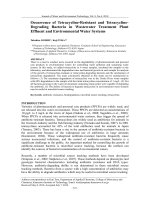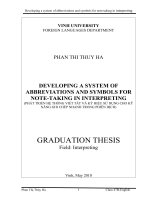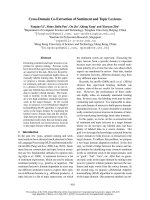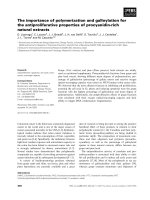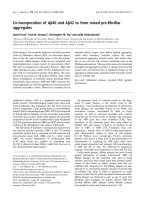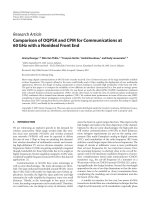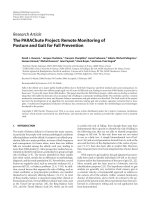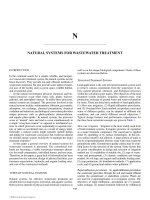Co culture of microalgae and bacteria for wastewater treatment coupling with biomass recovery
Bạn đang xem bản rút gọn của tài liệu. Xem và tải ngay bản đầy đủ của tài liệu tại đây (2.42 MB, 115 trang )
VIETNAM NATIONAL UNIVERSITY HO CHI MINH CITY
HO CHI MINH CITY UNIVERSITY OF TECHNOLOGY
--------------------
NGUYEN HONG HAI
CO-CULTURE OF MICROALGAE AND BACTERIA
FOR WASTEWATER TREATMENT COUPLING WITH
BIOMASS RECOVERY
NUÔI CẤY VI TẢO - VI KHUẨN CỘNG HỢP ĐỂ XỬ LÝ NƯỚC
THẢI KẾT HỢP VỚI THU HỒI SINH KHỐI
Major: Environmental Engineering
Code: 8520320
MASTER THESIS
HO CHI MINH CITY, February 2022
THIS RESEARCH IS COMPLETED AT
HO CHI MINH CITY UNIVERSITY OF TECHNOLOGY – VNU-HCM
Instructor: Assoc. Prof. Dr. Bùi Xuân Thành
Examiner 1 : Assoc. Prof. Dr. Nguyễn Thị Thanh Phượng
Examiner 2 : Assoc. Prof. Dr. Lê Đức Trung
Master’s Thesis defended at HCMC University of Technology, VNU-HCMC on
February 18, 2022
The Board of The Master’s Thesis Defense Council includes:
1. Chairman: Prof. Dr. Nguyen Van Phuoc
2. Secretary: Dr. Vo Thanh Hang
3. Examiner 1: Assoc. Prof. Dr. Nguyen Thi Thanh Phuong
4. Examiner 2: Assoc. Prof. Dr. Le Duc Trung
5. Member: Assoc. Prof. Dr. Nguyen Nhat Huy
Verification of the Chairman of the Master’s Thesis Defense Council and the Dean of
the Faculty of Environment & Resource after the thesis being corrected (if any).
CHAIRMAN
Prof. Dr. Nguyễn Văn Phước
DEAN OF FACULTY OF
ENVIRONMENT & RESOURCE
VIETNAM NATION UNIVERSITY HCMC
HCMC UNIVERSITY OF TECHNOLOGY
SOCIALIST REPUBLIC OF VIETNAM
Independence – Liberty - Happiness
THE TASK SHEET OF MASTER’S THESIS
Full name: Nguyễn Hồng Hải .............................................. Learner ID:1970162..............
Day of birth: 24/01/1996 ...................................................... Place of birth: Ho Chi Minh city
Major: Environmental Engineering ..................................... Major code: 8520320 ............
I. THESIS TOPIC:
Co-Culture Of Microalgae And Bacteria For Wastewater Treatment Coupling With
Biomass Recovery/ Nuôi Cấy Vi Tảo - Vi Khuẩn Cộng Hợp Dể Xử Lý Nước Thải Kết
Hợp Với Thu Hồi Sinh Khối
II. TASKS AND CONTENTS:
The study includes the following mission with relating contents as below:
1. Evaluate the formation and characterization of activated (microalgae + sludge)
granule in PBR with SBR mode
2. Definition of optimal operating conditions for cultivation of activated granules in
photobioreactor
3. Evaluation of batch MPBR for granular activated algae on biomass recovery and
wastewater treatment
III. TASKS STARTING DATE: 05/09/2022.................................................................
IV. TASKS ENDING DATE:18/12/2022 .......................................................................
V.
INSTRUCTOR: Assoc. Prof. Dr. Bùi Xuân Thành ..................................................
Tp. HCM, ngày tháng năm 20
INSTRUCTOR
HEAD OF DEPARTMENT
Assoc. Prof. Dr. Bùi Xuân Thành
DEAN OF FACULTY OF ENVIRONMENT & RESOURCE
i
ACKNOWLEDGEMENT
First of all, I would like to express my deep respect and appreciation to Assoc./Prof.
Bui Xuan Thanh, my career father, my inspirational advisor who gave me valuable
advice during my time studying and researching at Ho Chi Minh City University of
Technology. Without his dedication, enthusiasm, and erudite knowledge, I would
not be able to overcome the difficulties to complete this thesis and this study
Thank you so much my team Bird Fighter, Kim Qui – Hong Ngoc – Phuong Uyen,
for helping me so much from the very beginning of this study. Thanks guys, always
by my side to work with me during 2 years. It was a lot of memory with you, I
never forget.
Thank you, my seniors, my fellows in BIOSEP Research Group for helping me
improve my knowledge and practical skills during my time working with the group.
A special thanks to VINIF fund for granting me Master Scholarship which
supported me so much during my study time.
ii
ABSTRACT
In this study, activated algae granule was achieved by cultivated mixed culture
inside PBR. Granulation and wastewater treatment of activated algae from
Chlorella vulgaris microalgae strain and bacteria from AS was investigated through
4 different agitation speeds of 80, 120, 160, 200 rpm (shear stress of 0.04-0.69 Pa).
The stable ability in treating COD, ammonium, TP of activated algae, with the
highest achieved removal efficiency were 92%, 85% and 91%, respectively. During
granulation process, EPS and filamentous microalgae are the 2 main observed
factors contribute to the granule formation. Shear stres below 0.15 Pa could not
form granule. The largest granule was achieved at R200 – shear stress of 0.69 Pa
(339.1 µm), but R160 (shear stress 0.35 Pa) gave optimal results in terms of granule
formation time, as well as wastewater treatment efficiency. Shear stress from 0.04 –
0.15 Pa could guarantee mass transfer for the entire co-culture without aeration.
Shear stress from 0.15 – 0.69 Pa is a suitable range for the granulation process of
activated algae. The different strategy of EPS in the microbial community also
affected by various hydraulic shear force combining with the stress caused by
retention time.
The hydrodynamic shear by agitation was found to determine the structure of
granules and regulated the granulation including its transformation stage, the EPS
regulation and dominant microbial community. Therefore, the present study adds
insight into the comprehensive understanding of the effect of hydraulic shear stress
induce granulation formation on activated microalgae.
iii
TĨM TẮT
Trong nghiên cứu này, kích hoạt hạt tảo đã đạt được bằng nuôi cấy hỗn hợp nuôi
cấy bên trong PBR. Quá trình tạo hạt và xử lý nước thải của tảo hoạt tính từ chủng
vi tảo Chlorella Vulgaris và vi khuẩn AS được khảo sát thông qua 4 tốc độ khuấy
trộn khác nhau là 80, 120, 160, 200 vòng/phút (ứng suất cắt 0,04-0,69 Pa). Khả
năng xử lý COD, amoni, TP của tảo hoạt tính ổn định với hiệu suất xử lý đạt cao
nhất lần lượt là 92%, 85% và 91%. Trong quá trình tạo hạt, EPS và vi tảo dạng sợi
là 2 yếu tố quan sát chính góp phần hình thành hạt. Lực cắt dưới 0,15 Pa khơng thể
tạo thành hạt. Hạt lớn nhất đạt được ở R200 – ứng suất cắt 0,69 Pa (339,1 µm),
nhưng R160 (ứng suất cắt 0,35 Pa) cho kết quả tối ưu về thời gian tạo hạt cũng như
hiệu quả xử lý nước thải. Ứng suất cắt từ 0,04 – 0,15 Pa có thể đảm bảo chuyển
khối cho tồn bộ hệ thống đồng ni cấy mà khơng cần sục khí. Ứng suất cắt từ
0,15 – 0,69 Pa là khoảng thích hợp cho q trình tạo hạt của tảo hoạt tính. Chiến
lược khác nhau của EPS trong cộng đồng vi sinh vật cũng bị ảnh hưởng bởi lực cắt
thủy lực khác nhau kết hợp với ứng suất gây ra bởi thời gian lưu.
Lực cắt thủy động lực học bằng cách kích động đã được tìm thấy để xác định cấu
trúc của hạt và điều chỉnh quá trình tạo hạt bao gồm giai đoạn biến đổi của nó, quy
định EPS và cộng đồng vi sinh vật chiếm ưu thế. Do đó, nghiên cứu hiện tại bổ
sung cái nhìn sâu sắc về sự hiểu biết tồn diện về ảnh hưởng của ứng suất cắt thủy
lực gây ra sự hình thành hạt đối với vi tảo hoạt hóa.
iv
LỜI CAM ĐOAN
Tôi tên Nguyễn Hồng Hải, là học viên cao học ngành Kỹ thuật Mơi trường khóa
2019, mã số học viên 1970162. Tôi xin cam đoan: Luận văn cao học này là cơng
trình nghiên cứu khoa học thực sự của bản thân tôi, được thực hiện dưới dự hướng
dẫn của PGS.TS. Bùi Xuân Thành.
Các hình ảnh, số liệu và thông tin tham khảo trong luận văn này được thu thập từ
nguồn đáng tin cậy, đã qua kiểm chứng, được cơng bố rộng rãi và được tơi trích dẫn
rõ ràng ở phần Tài liệu tham khảo. Các bản đồ, đồ thị số liệu tính tốn và kết quả
nghiên cứu được tôi thực hiện nghiêm túc và trung thực. Tôi xin lấy danh dự và uy
tín của bản thân để đảm bảo cho lời cam đoan này.
GUARANTEE
My name is Nguyen Hong Hai, I am a graduate student in Environmental
Engineering, class of 2019, student number 1970162. I hereby declare that this
master thesis is my own true scientific research work. carried out under the
guidance of Assoc.Prof.Dr. Bui Xuan Thanh.
The images, data and reference information in this thesis are collected from reliable,
verified, widely published sources and are clearly cited by me in the References
section. The maps, graphs of calculated data and research results are done seriously
and honestly by me. I pledge my honor and reputation to back this statement.
Master Student
Nguyễn Hồng Hải
v
TABLE OF CONTENT
ACKNOWLEDGEMENT ......................................................................................... i
ABSTRACT ..............................................................................................................ii
GURANTEE ..............................................................................................................ii
TABLE OF CONTENT ........................................................................................ viii
LIST OF FIGURES ................................................................................................viii
LIST OF TABLES ..................................................................................................... x
ABBREVIATIONS ...................................................................................................xi
CHAPTER 1. INTRODUCTION ............................................................................. 1
1.1 General context ................................................................................................. 1
1.2 Objectives of the study ..................................................................................... 4
1.3 Research scope ..................................................................................................4
1.4 Research content ............................................................................................... 4
1.5 The meaning of the topic .................................................................................. 5
CHAPTER 2. LITERATURE REVIEW ................................................................. 6
2.1 Co-culture of Microalgae-Bacteria ...................................................................6
2.1.1 Wastewater treatment using microalgae-based systems ............................ 6
2.1.2 Interactions within co-culture .....................................................................7
2.1.3 Wastewater treatment by co-culture .........................................................11
2.1.4 Co-culture systems and configurations in wastewater treatment ............ 13
2.1.5 Challenges and operational conditions of co-culture system .................. 14
2.2 Microalgae – Bacteria flocculation .................................................................15
2.2.1 Bio-flocculation ........................................................................................ 15
2.2.2 Factors influencing bio-flocculation ........................................................ 17
vi
2.2.3 Flocs structure ...........................................................................................18
2.2.4 Challenges in bio-flocculation ..................................................................19
2.3 Activated Microalgae granules ........................................................................19
2.3.1 Characteristics of Activated Microalgae granules (AMGs) .................... 19
2.3.2 Influence factors on AMGs ...................................................................... 23
CHAPTER 3. MATERIALS AND METHOD ......................................................28
3.1 Overall reseach content ...................................................................................28
3.2 Microbial and synthetic wastewater ............................................................... 29
3.2.1
Microalgae and symbiotic bacteria strain ............................................. 29
3.2.2
Wastewater ............................................................................................ 31
3.3 Experimental set-up and operating conditions of photobioreactors (PBR)
system32
3.3.1
Experimental set up ............................................................................... 32
3.4 Analysis methods: ...........................................................................................35
CHAPTER 4. RESULTS AND DISCUSSION ......................................................44
4.1. Treatment performance ...................................................................................44
4.2. Microalgae activity profile ............................................................................. 51
4.3. Impact of shear stress on granulation process of AMGS ...............................55
4.3.1. Size distribution ..........................................................................................56
4.3.2. Settleability ................................................................................................. 60
4.3.3. EPS secretion ..............................................................................................60
4.3.4. Granulation mechanism ..............................................................................66
CHAPTER 5. CONCLUSIONS AND RECOMMENDATIONS ........................77
5.1. Conclusions .....................................................................................................77
vii
5.2. Recommendations ...........................................................................................77
REFERENCES .........................................................................................................78
PROFILE (Phần Lý Lịch Trích Ngang) .................................................................. 100
TRAINING PROCESS ............................................................................................100
WORKING PROCESS ............................................................................................100
viii
LIST OF FIGURES
Figure 2.1 Schematic representation of microalgae-bacteria interactions and
exchanged molecules during wastewater treatment (Ferro, 2019) ............................. 9
Figure 2.2 Microalgae-based technology for aerobic wastewater treatment
comparing with conventional activated sludge (Tiron et al, 2017) .......................... 10
Figure 2.3 Microalgae-bacteria granular formation ................................................. 20
Figure 3.1 Overall research contents ........................................................................ 28
Figure 3.2 Schematic diagram of photobioreactor (PBR) system ........................... 32
Figure 3.3 Scheme of sample preparation for bound EPS determination ................37
Figure 3.4 Flow profile of a fluid in PBR shows that the fluid acts in layers that
slide over one another (turbulent flow) ..................................................................... 40
Figure 4.1 a) COD removal performance b) Remaining COD concentration in
effluent of 4 different agitation speeds during the whole experiment ...................... 44
Figure 4.2 Nitrogen removal performance in terms of a) NH4 removal efficiency (%)
and effluent concentration (mg/L) of b) NO2 and c) NO3 .........................................47
Figure 4.3 a) TP removal performance b) Remaining TP concentration in effluent
of 4 different agitation speeds during the whole experiment ....................................49
Figure 4.4 Concentration of Chlorophyll a (µg/L) at various stages in the PBRs ...51
Figure 4.5 Activated algae in form of (a) flocs R80, and AMGS (b) R120, (c) R160,
(d) R200 in day 218 under microscope x10 magnification .......................................54
Figure 4.6 Comparison between AM/AMGs (left) with seed microalgae (right) ... 54
Figure 4.7 Total biomass concentration (mg/L) in a) mixed culture, b) Correlation
between Chl-a concentration and biomass ................................................................ 55
Figure 4.8 Particle size distribution (PSD) of 4 PBRs in a) day 165th (batch 67th), b)
day 216th (batch 90th) and c) linear correlation between shear stress and size
distribution during the whole treatment .................................................................... 57
ix
Figure 4.9 Settling rate (m/h) of AM/AMGs during the experiment .......................60
Figure 4.10 Bound EPS distribution over 5 stages of operation of a) R80, b) R120,
c) R160, d) R200 ........................................................................................................65
Figure 4.11 Granulation process of AMGS in R80 (a, b), R120 (c, d), R160 (e, f, g,
h, i, j), R200 (k, l) .......................................................................................................70
Figure 4.12 Microscope observation (10x magnification) from stage 1 to stage 5 of
AM and AMGS of 4 PBRs ........................................................................................ 76
Figure 4.13 Pictures of activated microalgae on day 218 (a) R80 (b) R120 (c) R160
(d) R200 ......................................................................................................................76
x
LIST OF TABLES
Table 3.1. Component of BBM medium (Bold 1949, Bischoft & Bold 1963) ........29
Table 3.2 Components of feed synthetic wastewater in experiment (1) + (2) .........31
Table 3.3 Operating condition for experiment (1) + (2) ...........................................34
Table 3.4 Batch cycle of SBR mode .........................................................................34
Table 3.5 Shear stress of 4 different agitation speeds based on above formulations
.................................................................................................................................... 41
Table 3.6 Sampling point and frequency .................................................................. 43
xi
ABBREVIATIONS
PBR
Photobioreactor
EPS
Extracellular polymeric substance
AOB
Ammonia oxidizing bacteria
NOB
Nitrite oxidizing bacteria
COD
Chemical oxygen demand
DO
Dissolved oxygen
WWTP
Wastewater treatment plant
AGS
Activated granular sludge
AMG
Activated Microalgae granule
AS
Activated sludge
ASP
Activated sludge process
TN
Total nitrogen
TP
Total phosphorus
N
Nitrogen
P
Phosphorus
RO
Reverse osmosis
SBR
Sequencing batch reactor
Chl-a
Chlorophyll a
R80
PBR with agitation speed of 80rpm
R120
PBR with agitation speed of 120rpm
R160
PBR with agitation speed of 160rpm
R200
PBR with agitation speed of 200rpm
1
CHAPTER 1.
INTRODUCTION
1.1 General context
Nowadays, biological processes have been mainly applied in wastewater treatment
plants especially activated sludge process (ASP). However, there are still many
drawbacks of biological process, for example, the need of pre-treatment, the high
energy requirement for aeration, stirring, and the low nutrient removal capacity
(Longo et al., 2016; Quijano et al., 2017). Moreover, the removal of P in wastewater,
which is usually done by chemical and physical processes (flocculation,
flocculation), causes high costs and low treatment efficiency (Cole et al., 2017).
From these existing shortcomings, the application of microalgae-based wastewater
treatment systems using wastewater as a source of nutrient has been successfully
developed in recent years, especially domestic wastewater has brought the positive
results in the ability to treat N, P and algae biomass recovery (Ruiz-Marin et al.,
2010; Li et al., 2019; Chiu et al., 2015). The advantage of using algae corresponds
with the ability to remove nitrogen and phosphorus in wastewater through the
assimilative process of biomass which have been studied such as post-treatment
process (Honda et al., 2017), urine (Tuan et al., 2014), aquaculture wastewater (Gao
et al., 2016), livestock wastewater (Garcia et al., 2017). Besides, microalgae-based
technology was considered as an environmental-friendly, low-cost and highefficiency method to reduce the concentration of carbon dioxide in the atmosphere
(Benemann, 1997; Klinthong et al, 2015; Zhou et al, 2017). In addition, utilizing
microalgae to convert carbon emission into biomass is regarded as one of the most
cost-effective method of CO2 reduction and gained biomass of algae could be used
as high-profit product like biofuels, food source, etc. (Chisti, 2007; Chiu et al.,
2015). However, widespread adoption of microalgae-based technology is
constrained in terms of design, operation, and biomass harvesting.
Since the microalgae has very small size (3 - 30 μm) and the settling rate is less than
3.6 x 10-3 m/h, it is difficult and expensive to separate microalgae from cultivation
2
media (Granados et al, 2012; Hu. et al, 2017). Thus, harvesting microalgae biomass
is a bottlenecks in developing production systems for manufacturing bioproducts or
applying microalgae to treat wastewater.
It is estimated that about 20 - 30% of
operating costs during the cultivation of microalgae are from the microalgae
biomass harvesting through coagulation/flocculation, centrifugation, flotation, etc.
(Renuka et al, 2013). Therein, centrifugation is the most popular method due to its
saving time but also the most energy-consuming method when it applies to
microalgae harvest at an industrial level, which is supposed to have a high energy
consumption (more than 3,000 kWh/ton of microalgae) (Schenk et al., 2008). In
addition, the coagulation method is also often used as a substitute for centrifugation
because of less energy consumption (Gerde et al. 2014). Nevertheless, this method
contains several drawbacks, such as the contamination of final product with metal
salts, high costs of chemicals and the difficult to operate (Granados et al, 2012). In
some recent studies, gravitational sedimentation which is applied to the harvesting
of microalgae is the most appropriate method with low cost and no energy
consumption. However, the main disadvantage of this method is the time it takes to
settle naturally as well as the yield and biomass gathering are low.
To present COD and nutrients treatment simultaneously in a compact area, enhance
the settling velocity of microalgae, thus providing an alternative co-culture of
microalgae in wastewater, the idea of combining bacteria and microalgae inside one
system has been developed and attracted attention of many researchers around the
world (Su, Mennerich and Urban, 2012). In 1972, the term "activated algae" was
used for the first time in experimental research of McGriff and McKinney to refer
the product of flocculation process between microalgae and bacteria during
wastewater treatment (McGriff and McKinney, 1972). Biological remediation by
activated algae has been tested recently in ponds and PBR, demonstrating their
potentiality in overcoming the individual application disadvantages of either
activated sludge and microalgae, such as high cost of aeration, large area
consumption and sludge handling problem (Boelee et al., 2014), (Marcilhac et al.,
2014). Currently, the microalgae-bacteria granular, which is considered to have a
3
good settling rate (21.6 ± 0.9 m/h), high biomass content and dense microbial
structure has operated successfully in closed culture system Photobioreactor (PBR)
(Liu et al., 2017; Tiron et al., 2015, 2017). After transferring the seed microalgae to
the aerobic granular sludge system (AGS), the formation of the microalgae-bacteria
aerobic granular occurred. Therein, extracellular polymers (EPS) plays an important
role in the process of granulation and maintaining the internal structure of particles
(Liu et al., 2017; Cai et al., 2019). Furthermore, the presence of filamentous
microalgae and the operational parameters of the culture system (stirring speed,
retention time, etc.) is also confirmed to play a major role in the granulation process
(Tiron et al, 2015, 2017). The symbiotic co-culture of microalgae and bacteria has
taken a lot of advantages, in consist of the ability to use carbon dioxide to produce
oxygen in order to decrease the need for aeration, the increase of nutrient removal
rate and the potential for high microalgae recovery efficiency (Tricolici et al., 2014;
Tang et al., 2016; Zhu et al., 2019). However, under continuous operating
conditions, maintaining a stable biomass concentration, substantial wastewater
treatment performance has not been interested in research and evaluation, especially
in term of operating condition of co-culture PBR (Quijano et al., 2017).
Therefor granulation of activated algae is expected to be the trend of future
wastewater treatment field. However, granulation process is influenced by many
operational conditions, such as reactor configuration, starvation, hydraulic shear
force and so on (Zhu et al., 2008), (Gao et al., 2011). These environmental
conditions also have a close relationship with growth rate and cell composition of
algae (Schenk et al., 2008), which have a direct correlation with removal
performance of activated algae wastewater treatment system. Therefore, a new
technology as granulation from activated algae also needs more information and
research to fulfill knowledge about the performance of this system, adapt utilization.
In this study, the co-culture of microalgae-bacteria is cultivated in sequencing batch
PBR containing synthetic wastewater at different operating parameters to determine
the optimum agitation speed in the stage of granular formation and the impact of
organic loading rate on granular. The granular is characterized by morphology,
4
settleability, distribution of microalgae-bacteria and the amount of EPS. The
efficiency of biomass recovery, organic matter & nutrient removal will be assessed
in detail. The results from this work will be the premise for the design of
microalgae-based systems to treat wastewater and harvest algae biomass, which is
high efficiency and low cost.
1.2 Objectives of the study
The topic “Co-Culture of Microalgae and Bacteria for Wastewater Coupling with
Biomass Recovery” will be an application of photobioreactor (PBR) with the coculture of microalgae-bacteria, operating in sequencing batch reactor (SBR) process
to treat synthesis domestic wastewater with high content of nutrients (N, P) and
organic (C), combining with microalgae biomass production-oriented produce bioproducts and reduce CO2.
1.3 Research scope
This research was conducted within the laboratory with the following contents:
Biological inoculum used for flocculation/granulation processes was
represented by Chlorella sp. mixing with aerobic activated sludge from
wastewater treatment system of supermarket (in MBR tank) with initial
biomass concentration 400 mg/L. The co-culture microalgae:activated sludge
mixing ratio was 5:1 (%w:%w)
Wastewater used for culture is artificial wastewater with C:N:P mass ratio is
about
100:10:1
corresponding
to
COD,
nitrogen
and
phosphorus
concentrations of 384 ± 20 mg L-1, 40 mgN L-1 and 4 mgP L-1, respectively.
In the PBR model, co-culture were cultured in four stirred photo-bioreactors
with a working volume of 7L under four different agitation speed of 80, 120,
160 and 200 rpm.
1.4 Research content
This study aim to achieve the following contents:
To form fully developed microalgae-bacteria granules.
5
To find the optimal agitation speed value for flocculation-granulation process
in PBR and wastewater treatment performance
Observing the effect of Organic loading rate (OLR) and/or Nitrogen loading
rate (NLR) on co-culture granular performance including granular
characteristic and wastewater treatment efficiency
1.5 The meaning of the topic
Scientific and practical significance
The topic contributed, supplemented and understood more about the effects of
optimal operating parameters and innovative process of microalgae-activated sludge
system on the development of granulation co-culture. Thereby, it applies to the
utilization of wastewater with appropriate nutritional content in algae culture to
recover high yield biomass for many potential applications from algae biomass. In
addition, the topic also serves as the basis for the next in-depth studies on a
promising microalgae-based technology.
Social meaning
With the need to meet the increasingly high quality of the living environment of the
society, finding and applying integrated green technology to reduce CO2 emissions
and nutrients in wastewater is a very necessary thing today, especially in Vietnam,
where the eutrophication is a challenge of industrial, agricultural wastewater. This
topic will contribute in the selection and development of a viable green technology
for utilizing nutrients in wastewater for microalgae biomass culture to serve many
potential applications for profit, and improving the quality of human life at low cost.
6
CHAPTER 2.
LITERATURE REVIEW
2.1 Co-culture of Microalgae-Bacteria
2.1.1 Wastewater treatment using microalgae-based systems
Microalgae-based technology in wastewater treatment has received growing
attention in recent years owing to its outstanding advantages, including (1)
simultaneously efficient N and P removal via microalgae photosynthetic
assimilation; (2) cost effective with environment friendly due to no additional
chemicals are required comparing to conventional treatment method, while oxygen
generation, carbon dioxide mitigation, and metal ion reduction can be realized at the
same time; and (3) potential utilization of the harvested microalgae biomass for
production of food, feed, fuel, fertilizers, food stocks for pharmaceutical industry,
etc. (Wang et al., 2017).
One of the main advantages of the use of microalgae for wastewater treatment is the
diversity of removal mechanisms for different types of pollutants. Nutrients
assimilation, nitrogen volatilization and phosphorous precipitation, aerobic
biodegradation of organic matter, ammonium removal through nitrification,
biosorption of heavy metals and pathogen disinfection due to pH fluctuations
(Wang et al., 2017). Overall, microalgae cultivation using wastewater as the growth
medium has multiple applications in bio-products, carbon dioxide mitigation and
bioremediation. The microalgae systems can treat human sewage, livestock wastes,
agro-industrial wastes and industrial wastes. Also, microalgae systems for the
treatment of other wastes such as piggery effluent, the effluent from food processing
factories and other agricultural wastes have been investigated. Also, microalgae
based system for the removal of toxic minerals such as lead, cadmium, mercury,
scandium, tin, arsenic and bromine are also being developed (Abdel-Raouf et al.,
2012)
Microalgae have a high potential to be applied for the treatment of nutrient rich
wastewaters due to high capacity for nutrient uptake. Consequently, microalgae
